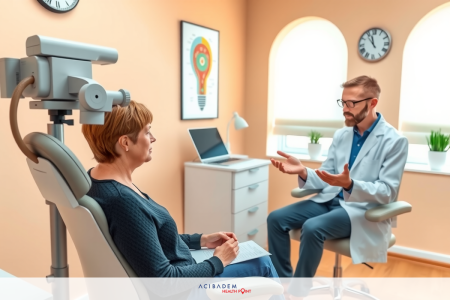Is Glaucoma and Cataract the Same?
Is Glaucoma and Cataract the Same? Many people wonder if Glaucoma and Cataract are the same. These eye problems may affect sight but are quite different. This article will talk about glaucoma versus cataract. It will explain what makes them unique. By distinguishing glaucoma and cataract, we help people learn clearly about these eye diseases.
Introduction to Glaucoma and Cataract
It’s important to know how glaucoma and cataract differ. This knowledge helps keep our eyes healthy. They both hurt vision and life quality. But, they’re often mixed up, especially in older adults. Let’s get a quick look at these eye problems. We need to learn how to tell them apart.
Cataract vs glaucoma is a common eye health topic. They can both make it hard to see well. But they’re not the same. Cataracts make your eye’s lens cloudy. This often happens as you get older. Yet, glaucoma is about the optic nerve. It can get damaged from pressure inside the eye.
Knowing the similarities glaucoma and cataract have is also key. If they’re not treated, both can make you blind. They mostly show up as you get older. But, how we tackle them is very different. For cataracts, we do surgery. This surgery puts in a new lens. But with glaucoma, we might use medicines or surgery to lower eye pressure.
Learning about the differences and similarities in cataract vs glaucoma is a smart step. It can help you catch them early and treat them well. This info is great for taking care of your health. It also helps when talking to doctors for the best results.
What is Glaucoma?
Glaucoma is a problem with the eyes that can hurt the optic nerve. This can happen if there is too much pressure in the eye. It’s important to know that Glaucoma and Cataracts are not the same. They need different kinds of care.
Causes of Glaucoma
High eye pressure is a big cause of Glaucoma. This pressure builds when the eye can’t drain fluid well. Things like your genes, age, and health can also play a part.
Symptoms of Glaucoma
The signs of Glaucoma can change with type and stage. Look out for:
- Blurred vision
- Severe eye pain
- Headaches
- Haloes around lights
- Nausea and vomiting (in acute cases)
Finding these signs early can help keep your eyesight safe.
Treatments for Glaucoma
Glaucoma treatment aims to lower eye pressure. Here’s how doctors help:
- Medications: Eye drops or pills can reduce eye pressure. They’re often tried first.
- Laser Therapy: Laser surgery can help the eye drain fluid better.
- Surgery: Sometimes, doctors must do surgery to lower the eye’s pressure.
It’s key to know how Glaucoma and Cataracts are different. Their treatments are not the same.
What is Cataract?
A cataract makes the eye lens cloudy, leading to unclear vision. It mostly happens as we get older. Tiny pieces break off the lens and make it hard to see clearly.
This issue grows over time and can affect just one or both eyes. Things look dim and blurry, especially at night. You might also see ‘halos’ around lights and feel sensitivity to light. Colors can look less bright or more yellow.
It’s important to know cataracts aren’t the same as glaucoma. Cataracts cloud the lens. But glaucoma is about pressure that harms the optic nerve. So, treatment for each is different since they affect the eyes in unique ways.
For bad cataracts, everyday tasks become hard. But, a simple surgery can remove the cloudy lens. Then, a new lens takes its place. This operation helps a lot since it can fix your vision. It’s way more successful than treating glaucoma.
| Aspect | Glaucoma | Cataract |
|---|---|---|
| Cause | Increased intraocular pressure | Protein clumping due to aging |
| Symptoms | Peripheral vision loss, eye pain | Blurred vision, faded colors, glare |
| Progression | Gradual with possible permanent damage | Slow and generally treatable with surgery |
| Treatment | Medications, laser treatment, surgery | Surgery to replace the lens |
Comparing glaucoma and cataracts shows their unique impacts and treatments. Recognizing these differences helps manage eye health better. It also ensures the right care at the right time.
Is Glaucoma and Cataract the Same?
Many people get mixed up about glaucoma and cataract. They both can harm vision. But, they are different in how they start, what they do, and how they are treated.
Common Misconceptions
A lot of folks think glaucoma and cataract are alike because they both can cause sight issues. But, learning about each one helps spot the differences.
- Glaucoma: This mostly hurts the optic nerve. It’s usually from high eye pressure. It can make people lose vision forever, but there are many types of glaucoma.
- Cataract: Cataract makes your eye lens cloudy. It can happen with age. But, it’s fixable with surgery to make your vision clear again.
Knowing the facts helps tell them apart. It means better care and treatment plans. This makes sure people get the right help for their eyes.
| Criteria | Glaucoma | Cataract |
|---|---|---|
| Nature of Condition | Damage to the optic nerve due to high intraocular pressure | Clouding of the eye’s lens |
| Common Symptoms | Peripheral vision loss, eye pain, halos around lights | Blurred vision, glare sensitivity, faded colors |
| Treatment Options | Eye drops, laser therapy, surgery to reduce eye pressure | Surgical removal of the clouded lens |
| Reversibility | Vision loss is typically irreversible | Vision can be restored with surgery |
Difference Between Glaucoma and Cataract
It’s important to tell the difference between glaucoma and cataract. Knowing their unique features helps with diagnosis and the right treatment.
| Aspect | Glaucoma | Cataract |
|---|---|---|
| Definition | A group of eye conditions causing optic nerve damage due to high intraocular pressure. | A clouding of the eye’s lens, leading to decreased vision clarity. |
| Causes | Primarily increased intraocular pressure, but can also result from genetics and other health issues. | Mostly age-related, but also caused by trauma, radiation, and certain medications. |
| Symptoms | Often asymptomatic in early stages; progressive loss of peripheral vision. | Blurry vision, glare sensitivity, and reduced night vision. |
| Progression | Gradual and can lead to irreversible blindness if untreated. | Slowly develops over years and is usually treatable with surgery. |
| Impact on Vision | Peripheral vision loss leading to tunnel vision. | Overall vision blurriness and dimming. |
Knowing the difference between glaucoma and cataract helps catch them early. This leads to the right treatment and better vision. Early help can keep sight good and life happy for those with these problems.
Similarities Between Glaucoma and Cataract
Glaucoma and cataract are eye problems that are quite different. But, they have a few things in common that might confuse some people. It’s important to know these common features. This knowledge can help you understand these eye problems better. And it shows why taking good care of your eyes is crucial.
Age plays a big role in both glaucoma and cataract. As people get older, their chances of having these issues go up. A family history of eye problems, diabetes, and taking steroids for a long time are also shared risk factors. Even high blood pressure and past eye injuries can make someone more likely to get these conditions.
Age-Related Development
As you get older, you’re more likely to have glaucoma or cataract. Changes in your eyes from aging can lead to these problems. After turning 60, the chances of having these issues get higher. This is why regular eye check-ups are important as you age. They can help spot and maybe even prevent these problems early on.
Possible Coexistence
It’s possible for someone to have both glaucoma and cataract together. This makes things harder to diagnose and treat. They can both affect your vision a lot. Treating someone with both problems needs a careful plan. This might involve treating the pressure inside your eye from glaucoma and making the cloudy lens in cataract clear again. So, seeing a doctor who knows a lot about eyes is very important if you have both problems.
| Aspects | Glaucoma | Cataract | Commonality |
|---|---|---|---|
| Age of Onset | Usually >40 years | Usually >60 years | Increases with Age |
| Main Risk Factors | High intraocular pressure | Lens opacity | Age, Family history, Diabetes |
| Symptom Overlap | Vision loss | Blurry vision | Impact on Vision |
| Potential Coexistence | Yes | Yes | Common |
Comparing Glaucoma and Cataract Treatments
Comparing glaucoma and cataract treatments shows we need different approaches. Glaucoma focuses on lowering eye pressure. Cataract treatment aims to make the lens clear again.
There are different ways we compare glaucoma and cataract treatments:
- Glaucoma Treatments:
- Doctors often use eye drops to reduce eye pressure.
- Oral medications can help if drops are not enough.
- Special laser treatments can help improve fluid drainage.
- Surgeries like trabeculectomy can create new drainage pathways.
- Cataract Treatments:
- At first, using glasses might help improve vision.
- Doctors can remove the cloudy lens through surgery.
- They can place an artificial lens to make vision clear again.
To compare glaucoma and cataract treatments well, we need to look at what they do. Here’s a helpful chart:
| Treatment Aspect | Glaucoma | Cataract |
|---|---|---|
| Primary Focus | Lowering intraocular pressure | Removing cloudy lens |
| Non-Surgical Options | Eye drops, medications, laser therapy | Start with corrective lenses |
| Surgical Options | Surgeries, like trabeculectomy | Surgeries, like phacoemulsification |
| Prognosis | Focus is on saving vision | Cataract surgery often restores clear vision |
New glaucoma and cataract treatments have come a long way. By focusing on each condition’s needs, we see better results. Glaucoma treatment helps keep vision safe. Cataract surgery often brings back clear vision.
Resources and Support: Acibadem Healthcare Group
Acibadem Healthcare Group is a top provider for eye care like glaucoma and cataract. Their high-tech places and new treatments help patients a lot.
People with glaucoma or cataract find help at Acibadem. They offer everything from early checks to surgery with the latest tech. Everyone gets a plan that fits just for them.
Acibadem is great because many experts work together. Everyone from eye doctors to surgeons helps in your care. They make sure you’re looked after well from start to finish.
| Aspect | Acibadem Healthcare Group |
|---|---|
| Specialized Care | Personalized treatment plans for glaucoma and cataract |
| Facilities | Modern, state-of-the-art technology and infrastructure |
| Treatment Options | Incorporates the latest in medical and surgical interventions |
| Professional Expertise | Multidisciplinary team of ophthalmologists and healthcare specialists |
If you face glaucoma or cataract, Acibadem Healthcare Group provides great help and advanced care. They focus on each person. This way, you get top care that’s just right for you.
Distinguishing Glaucoma and Cataract: Final Thoughts
It’s key to know the differences between glaucoma and cataracts for the right treatment. They both hurt sight but in different ways. Glaucoma damages the optic nerve while cataracts make the eye’s lens cloudy, mainly as you get older.
Getting regular eye checks is super important. It helps catch these conditions early. Early spotting can stop glaucoma from getting worse. And cataract surgeries can boost your sight a lot. This shows why it’s crucial to treat each condition with care.
So, telling glaucoma and cataract apart is good for your overall eye health. Being alert and taking the advice of eye doctors can really make life better. Always remember, finding them early means you can get the best care and prevent big vision problems.
FAQ
Is Glaucoma and Cataract the Same?
No, glaucoma and cataract are not the same. Glaucoma damages the optic nerve due to high eye pressure. Cataract makes the lens of the eye cloudy, often as we get older.
What are the similarities between glaucoma and cataract?
Both can come with age and harm eyesight. They share risks like family history and diabetes. Some have both.
What causes glaucoma?
Glaucoma's main cause is high eye pressure hurting the optic nerve. Family background, age, diabetes, and high blood pressure play roles too.
What are the symptoms of glaucoma?
Glaucoma might show as lost side vision, eye pain, seeing halos, or red eyes. Some don’t notice symptoms until it's well along.
What treatments are available for glaucoma?
Treatments aim to reduce eye pressure. They can be eye drops, pills, laser, or surgery.
What is a cataract?
A cataract makes the eye's lens cloudy, leading to poor vision. It might cause trouble with night vision, sensitivity to light, and seeing halos.
How do glaucoma and cataract differ?
Glaucoma harms the nerve due to eye pressure, resulting in vision loss. Cataracts cloud the lens, causing blurry vision. Glaucoma is treated with medicine and surgery. Cataracts are fixed by removal and lens replacement.
Can glaucoma and cataract occur together?
Yes, it's possible to have both. It’s very important to treat both at the same time for the best results.
What are the risk factors for both glaucoma and cataract?
Similar risks include getting older, family history, diabetes, and specific drugs. Also, long-term use of corticosteroids.
How are treatments for glaucoma and cataract similar or different?
Glaucoma and cataract treatments both require care aimed at maintaining eye health. Glaucoma works on lowering eye pressure; cataracts need surgery to replace the cloudy lens. Make sure to have regular eye check-ups for both.
What resources and support does Acibadem Healthcare Group offer for glaucoma and cataract patients?
The Acibadem Healthcare Group cares for those with glaucoma and cataracts. They offer modern diagnostics, treatments, and overall care to fight these eye diseases effectively.
Why are regular eye examinations important for distinguishing glaucoma and cataract?
Regular eye checks are key to catching and treating glaucoma and cataracts early. They can spot changes and get you the right help in time. This is vital for keeping your eyes healthy and your vision clear.













